
Derailleur gears are a variable-ratio transmission system commonly used on bicycles, consisting of a chain, multiple sprockets of different sizes, and a mechanism to move the chain from one sprocket to another. Although referred to as gears in the bike world, these bicycle gears are technically sprockets since they drive or are driven by a chain, and are not driven by one another.

A hub gear, internal-gear hub, internally geared hub or just gear hub is a gear ratio changing system commonly used on bicycles that is implemented with planetary or epicyclic gears. The gears and lubricants are sealed within the shell of the hub gear, in contrast with derailleur gears where the gears and mechanism are exposed to the elements. Changing the gear ratio was traditionally accomplished by a shift lever connected to the hub with a Bowden cable, and twist-grip style shifters have become common.
A groupset or gruppo is a bicycle component manufacturer's organized collection of mechanical parts. It generally refers to all of the components that make up a bicycle excluding the bicycle frame, fork, stem, wheels, tires, and rider contact points, such as the saddle and handlebars.
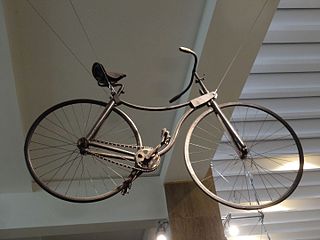
A safety bicycle is a type of bicycle that became very popular beginning in the late 1880s as an alternative to the penny-farthing ("ordinary") and is now the most common type of bicycle. Early bicycles of this style were known as safety bicycles because they were noted for, and marketed as, being safer than the high wheelers they were replacing. Even though modern bicycles use a similar design, the term is rarely used today and is considered obsolete outside circles familiar with high wheelers.
SunTour (Maeda) was the most important Japanese manufacturer of bicycle components based in Osaka until 1988, when Sakae Ringyo Company, a major Japanese maker of aluminum parts, particularly cranks and seat posts, bought what was left of the bankrupt SunTour, and the combined companies are now known as SR-SunTour. SunTour reached a zenith of sales and commercial success from the late 1970s to the mid-1980s. Its products range from suspension forks to derailleurs.

Joe Breeze is a bicycle framebuilder, designer and advocate from Marin County, California. An early participant in the sport of mountain biking, Breeze, along with other pioneers including Gary Fisher, Charlie Kelly, and Tom Ritchey, is known for his central role in developing the mountain bike. Breeze is credited with designing and building the first all-new mountain bikes, which were called Breezers. He built the prototype, known as Breezer #1, in 1977 and completed nine more Series I Breezers by early 1978. Breezer #1 is now in the collection of the Smithsonian Institution’s National Museum of American History.
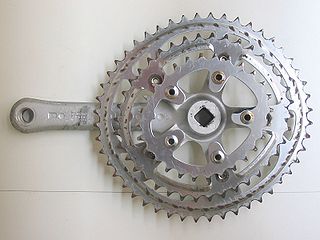
Biopace is a tradename for a type of ovoid bicycle chain ring manufactured by Shimano from 1983 to 1993 The design was intended to help overcome the "dead zone" where the crank arms are vertical and riders have little mechanical advantage.
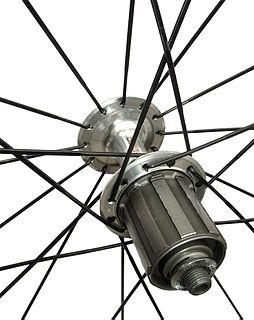
A freehub is a type of bicycle hub that incorporates a ratcheting mechanism.
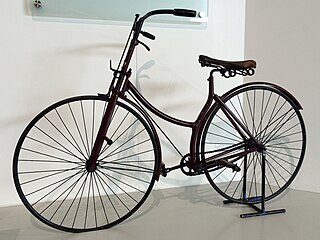
John Kemp Starley was an English inventor and industrialist who is widely considered the inventor of the modern bicycle, and also originator of the name Rover.

A bicycle mechanic or bike mechanic is a mechanic who can perform a wide range of repairs on bicycles. Bicycle mechanics can be employed in various types of stores, ranging from large department stores to small local bike shops; cycling teams, or bicycle manufacturers.

Sheldon Brown was an American bicycle mechanic, technical expert and author. He contributed to print and online sources related to bicycling and bicycle mechanics, in particular the web site Sheldon Brown's Bicycle Technical Info. His knowledge of bicycles was described as "encyclopaedic" by The Times of London.

Mount Tamalpais and the surrounding areas in Marin County, California are recognized as the birthplace of modern mountain biking. In the 1970s, mountain biking pioneers such as Gary Fisher, Otis Guy, Charlie Kelly and Joe Breeze were active. The 2006 film Klunkers chronicled their story, solidifying Mount Tamalpais' status as a mountain biking destination, as did Frank J. Berto's book The Birth of Dirt.

Oscar Egg was a Swiss track and road bicycle racer. He captured the world hour record three times before the First World War and won major road races and stages of the Tour de France and Giro d'Italia. He was also a noted developer of racing bicycles and bicycle components including lugs and derailleurs.
Centurion was a brand of bicycles created in 1969 by Mitchell (Mitch) M. Weiner and Junya (Cozy) Yamakoshi, who co-founded Western States Import Co. (WSI) in Canoga Park, California to design, specify, distribute and market the bicycles. The bikes themselves were manufactured initially in Japan by companies including H. Teams Company of Kobe and later in Taiwan by companies including Merida. The Centurion brand was consolidated with WSI's mountain bike brand Diamond Back in 1990. WSI ceased operations in 2000.

Bicycle drivetrain systems are used to transmit power on bicycles, tricycles, quadracycles, unicycles, or other human-powered vehicles from the riders to the drive wheels. Most also include some type of a mechanism to convert speed and torque via gear ratios.

A quick release skewer is a mechanism for attaching a wheel to a bicycle. It consists of a rod threaded on one end and with a lever operated cam assembly on the other. The rod is inserted into the hollow axle of the wheel, a special nut is threaded on, and the lever is closed to tighten the cam and secure the wheel to the fork. Wheels equipped with quick release mechanisms can be removed from the bicycle frame and replaced without using tools by opening and closing the cam lever, thus more quickly than wheels with solid axles and nuts. On the negative side, a quick-release hub renders a wheel more vulnerable to theft and care must be taken to ensure that the mechanism is properly tightened.
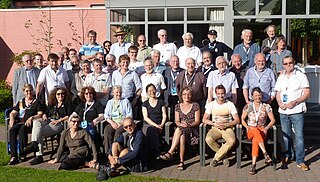
The International Cycling History Conference (ICHC) is an annual event devoted to applying academic rigor to the history of bicycles and cycling. The first conference was held in Glasgow, Scotland in 1990. The proceedings of each conference are published afterwards.

Whippet was a brand of safety bicycle designed by C. M. Linley and manufactured by Linley and Briggs in London. Examples exist from 1885 and 1888. They are notable for their use of springs to suspend the frame. An early external derailleur, that enabled two gear ratios, was available only on Whippet bicycles. | pages = 58–61

A gearbox bicycle is a bicycle that uses a gearbox to convert torque and rotational speed from the power source, usually the rider's legs, to what is desired at the drive wheel. The gearbox is usually incorporated into the frame near the crank, and it may be used in addition to or instead of derailleur gears or a hub gear. Cited advantages include improved shifting performance, protecting the gearing from damage and exposure to dirt and moisture, as with hub gears, plus locating the additional mass between the two wheels and on the frame where it may be suspended, unlike with hub gears.

The Croce d'Aune is a mountain pass in the Italian Dolomites, 1,015 metres (3,330 ft) above sea level, between Aune and Pedavena in Belluno Province.

















